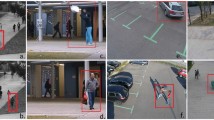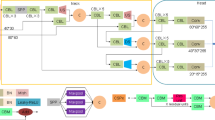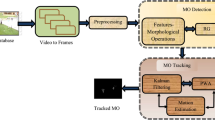Abstract
Aiming at the problem that the detection process is complex, which leads to the poor detection effect of degraded image spots, an intelligent detection technology of degraded image sequence spots based on machine vision is proposed. The binary mask image is obtained through the mathematical model of degraded image spots, and the existing spots in the degraded image are detected, and the probability density of candidate spots detected in the neighborhood of the degraded image is calculated, according to the principle that the probability density of the actual candidate spots is less than that caused by noise, the problem of high false detection rate caused by defects and noise is solved. The experimental results show that the method has high accuracy, wide detection range and high signal-to-noise ratio.





Similar content being viewed by others
References
Sangaiah AK, Samuel OW, Li X, Abdel-Basset M, Wang H (2018) Towards an efficient risk assessment in software projects–Fuzzy reinforcement paradigm. Comput Electr Eng 71:833–846
Zhao Y, Jiang H, Chen Q, Qin Y, Xie H, Wu Y, Liu S, Zhou Z, Xia J, Zhou F (2021) Preserving Minority Structures in Graph Sampling. IEEE Trans Vis Comput Graph 27(2):1–10
Lin Y, Tu Y, Dou Z et al (2021) Contour stella image and deep learning for signal recognition in the physical layer. IEEE Trans Cogn Commun Netw 7(1):34–46
Kumaran N, Reddy US (2020) Classification of human activity detection based on an intelligent regression model in video sequences. IET Image Process 1–12
Wei W, Song H, Li W, Shen P, Vasilakos A (2017) Gradient-driven parking navigation using a continuous information potential field based on wireless sensor network. Inf Sci 408(2):100–114
Zhao Y, Luo X, Lin X, Wang H, Kui X, Zhou F, Wang J, Chen Y, Chen W (2020) Visual Analytics for Electromagnetic Situation Awareness in Radio Monitoring and Management. IEEE Trans Vis Comput Graph 26(1):590–600
Liu S, Wang S, Liu X et al (2021) Fuzzy Detection aided Real-time and Robust Visual Tracking under Complex Environments. IEEE Trans Fuzzy Syst 29(1):90–102
Tu Y, Lin Y, Wang J et al (2018) Semi-Supervised Learning with Generative Adversarial Networks on Digital Signal Modulation Classification. Comput Mater Continua 55(2):243–254
Sangaiah AK, Medhane DV, Han T, Hossain MS, Muhammad G (2019) Enforcing position-based confidentiality with machine learning paradigm through mobile edge computing in real-time industrial informatics. IEEE Trans Ind Informat 15(7):4189–4196
Liu S, Wang S, Liu X, Gandomi AH, Daneshmand M, Muhammad K, de Albuquerque VHC (2021) Human Memory Update Strategy: A Multi-Layer Template Update Mechanism for Remote Visual Monitoring. IEEE Trans Multimedia 99:1–1. https://doi.org/10.1109/TMM.2021.3065580
Lin Y, Zhao H, Ma X et al (2021) Adversarial Attacks in Modulation Recognition with Convolutional Neural Networks. IEEE Trans Reliab 70(1):389–401
Liu S, Guo C, Al-Turjman F et al (2020) Reliability of response region: A novel mechanism in visual tracking by edge computing for IIoT environments. Mech Syst Signal Process 138:106537
Zhao W, Guo Y, Yang S et al (2020) Fast intelligent cell phenotyping for high-throughput optofluidic time-stretch microscopy based on the XGBoost algorithm. J Biomed Opt 25(6):1
Amodio A, Ermidoro M, Maggi D et al (2018) Automatic Detection of Driver Impairment Based on Pupillary Light Reflex. IEEE Trans Intell Transp Syst 1–11
Mal’Kovskii VI, Yudintsev SV, Mokhov AV et al (2018) Leaching of Degraded Preservative Matrices, Based on Sodium Aluminophosphate Glasses for High-Level Wastes. At Energy 123(3):177–182
Flores SM, Dumon M, Martínez PE et al (2020) Development of a new compound based on low-density polyethylene degraded with zeolite waste for the removal of diesel from water. J Environ Manag 271:110939
Martin Nieto R, Garcia-Martin A, Hauptmann AG et al (2019) Automatic Vacant Parking Places Management System Using Multicamera Vehicle Detection. IEEE Trans Intell Transp Syst 20(3):1069–1080
Jin K, Zhou M et al (2018) Computer-aided diagnosis based on enhancement of degraded fundus photographs. Acta Ophthalmol 96(3):e320–e326
James BT, Luczak BB, Girgis HZ (2018) MeShClust: an intelligent tool for clustering DNA sequences. Nucleic Acids Res 14:14
Hervas J, Barrera D, Madrigal J et al (2018) Microwave Photonics Filtering Interrogation Technique Under Coherent Regime For Hot Spot Detection on a Weak FBGs Array. J Light Technol 4:1–1
Zhu Y, Liao M, Yang M et al (2018) Cascaded Segmentation-Detection Networks for Text-Based Traffic Sign Detection. IEEE Trans Intell Transp Syst 19(1):209–219
Wei X, Jiang S et al (2019) Defect Detection of Pantograph Slide Based on Deep Learning and Image Processing Technology. IEEE Trans Intel Transp Syst 21(3):947–958
Silva EKND, Santos VBD, Resque IS et al (2020) A fluorescence digital image-based method using a 3D-printed platform and a UV-LED chamber made of polyacid lactic for quinine quantification in beverages. Microchem J 157:104986
Jing S, Hui F, Zhao X et al (2019) Cooperative Game Approach to Optimal Merging Sequence and On-Ramp Merging Control of Connected and Automated Vehicles. IEEE Trans Intell Transp Syst 99:1–11
Anagnostou G, Boem F, Kuenzel S et al (2019) Observer-Based Anomaly Detection of Synchronous Generators for Power Systems Monitoring. IEEE Trans Power Syst 33(4):4228–4237
Lin CY, Muchtar K, Lin WY et al (2020) Moving Object Detection through Image Bit-Planes Representation without Thresholding. IEEE Trans Intell Transp Syst 21(4):1404–1414
Author information
Authors and Affiliations
Corresponding author
Additional information
Publisher's Note
Springer Nature remains neutral with regard to jurisdictional claims in published maps and institutional affiliations.
Rights and permissions
About this article
Cite this article
Tian, Q., Wang, S. & Pan, L. Intelligent Spot Detection for Degraded Image Sequences Based on Machine Vision. Mobile Netw Appl 27, 2429–2436 (2022). https://doi.org/10.1007/s11036-021-01888-1
Accepted:
Published:
Issue Date:
DOI: https://doi.org/10.1007/s11036-021-01888-1




